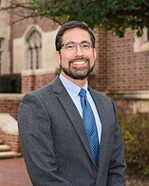Published on : May 13, 2021


By Pari Shah, LCSW, and Michael Talamantes, LCSW
In January of 2021, I returned to campus for the first time in nearly a year due to the COVID-19 global pandemic for a teaching practicum in the Social Work in Health MSW course with Clinical Professor Michael Talamantes. As a second year PhD student at the Graduate School of Social Work at the University of Denver, my dual role as both student and instructor gave me a unique perspective of what returning to campus means for both students and faculty. Walking through the eerie halls of the building that used to be the sacred space for my academic pursuits reminded me of the early pandemic days in 2020. White boards with year old “out of office” and “happy spring break” notes reminded me of the true level of havoc the pandemic wreaked on all of our lives.
Coming back to the school that once represented collaboration and community rather than fear or loneliness initially provoked feelings of anxiety and frustration for me. While I wanted to feel excitement on my return to campus, the residual effects of the pandemic reminded me that this space may not be what it used to be. While I do hope that school will again become a space where ideas can be shared and connection can be fostered, I am aware of the long road ahead of us to reach that sensation in this space again. After a 10-week course on campus, my anxiety and frustration shifted toward cautious comfort and optimism for future moments of togetherness, development, and mentorship with new social work students on campus.
Those first few weeks back on campus with my faculty mentor, Professor Talamantes, also brought hesitant and cautious students into the classroom. The students’ emotions were a reflection of my own, including anxiety, frustration, and isolation mixed with a desire for connection and collaboration. As we observed the students flow into the classroom, some were more comfortable than others. The more hesitant students tended to sit around the perimeter of the classroom, while those who were more comfortable with socializing tended to sit in the middle of the classroom. Some students double masked while others single masked, reflecting who more closely was in tune with CDC guidelines. Some students had received the vaccine and others had not, which was also echoed in their comfortability in the classroom. On an interpersonal level, some students had worked together in the virtual classroom but never had met in person, and these first few weeks brought about an awkward joy as we all tried to learn how to socialize once again. In pair share activities, some students spoke over the lengths of 6 feet apart, and others had to be reminded to create space.
The impact of the pandemic on students, staff, and faculty has been profoundly traumatic. Now, as we all consider what returning to campus will look like, we must re-create our current understanding of pedagogy. While we all experienced this collective trauma, a year in isolation, and trying to find meaning and re-creation of our habits and systems, we must resume our positions in academia with the same flexibility that we found within ourselves during the pandemic. This past year reminded us of what really matters—the health of our community, the deconstruction of White supremacist systems, the time with our loved ones, or the power of community care in healing. We must not let the pressure and bureaucracy of academia cloud our clarity of what’s important as we resume our roles. We must return to campus with the same gentleness and flexibility in our pedagogy as we carried this past year. Students are very much still coping with the consequences of the pandemic, and the present moment provides an imminent opportunity for us, as faculty members, to change academia at its core.
When we welcome students back to campus, we must strive to empathize with their experiences of walking these haunted halls. The fears that we all have once held about the pandemic, our students have also held deeply. As we find our footing in learning how to teach again in person, some things will remain the same, such as technology struggles and awkward silences that we can no longer attribute to “oh, you’re muted.” The building will be just as we left it, but everyone walking through those classroom doors has changed.
Historically, academia has implemented systems that have prioritized and upheld folks who have overworked, sacrificed their self-care, or carried privileged identities. Some pedagogical strategies to consider for the creation of more equitable and person-centered classrooms when returning to campus are considered in the following paragraphs.
Honoring the Value of Connection
Rather than participation being the smallest percentage of your student’s grade, consider rewarding the strength it takes to walk back onto campus after this past year. The notion of students returning to campus is emotional; whether these are new or former students, returning to campus symbolizes a season of change and immense hope for the future. As instructors, we must acknowledge what showing up in person after experiencing extreme isolation and fear for the past year entails. We can do this by increasing the emphasis placed on student participation. Showing up, engaging in the material, and connecting with one’s peers should be upheld over the individualist success mindset. Simultaneously, grace should be given to those who struggle in the classroom setting.
Implementing a Progressive Grading System
During the Health in Social Work in-person course, my mentor and I implemented a progressive grading system as a way to strike a balance between upholding rigor and providing flexibility to the students. This method worked in a curvilinear fashion, one which ebbs and flows to account for the stress of the quarter. At the start of the quarter, you may demonstrate rigor and quality of work through more strict grading policies on smaller assignments. As the assignments increase in size and weight, maintaining more rigorous grading while implementing more flexibility with the smaller assignments is helpful. While we are aware of the traditional framework of asserting a consistent, unbiased, inflexible grading policy in the syllabus, we all also know that this academic stiffness is outdated. We must consider a progressive grading system, or a healthy dose of manageable inconsistency, to assert flexibility and rigor in our education. Each student is unique, making it impossible to apply consistent and steadfast grading policies.
Befriending Humor
In these stressful and anxiety-stricken times of returning to campus, humor can be our friend when used appropriately. Using humor to bring light into a dark situation must be carefully curated so as to not promote insensitivity to the current global situation. Albeit difficult to return to campus, the classroom is a space in which lightness and laughter can cut through some of the grief and darkness we all experienced this past year. Befriending humor may not always mean reciting the most recent pop culture reference or inserting dry sarcasm; it may be as simple as laughing at oneself for technical difficulties, discussing the power of humor in social work settings, and reminding students that they each have their own sense of humor that can be used to cope during difficult times or connect with clients. Fostering a sense of connection and compassion in the classroom can often be done through the use of humor, and in such stressful times, allowing the classroom to feel a bit less tense is important.
In practicing these three strategies, my mentor and I found that we were able to shift from feelings of hesitancy and anxiety in the classroom to openness, curiosity, and connection with our students. Returning to campus allows students to grow academically and personally if tended to with flexibility. The students were able to feel like learners again, which gave them a small reprieve from the harsh world we are currently living in. While returning to campus is difficult, the benefits of fostering collaborative learning through equitable education practices will seep back into the world and carry us forward through and beyond the pandemic.
Contact the Authors
Pari Shah, LCSW
2nd Year PhD Student
Graduate School of Social Work
University of Denver
[email protected]
Michael Talamantes, LCSW
Clinical Professor
Graduate School of Social Work
University of Denver
[email protected]
This content was submitted to CSWE. For more information on publishing essays and content on CSWE’s website, please contact [email protected].
